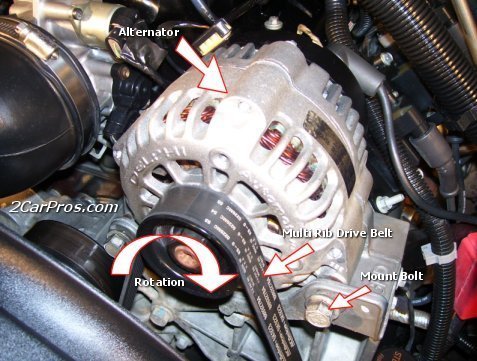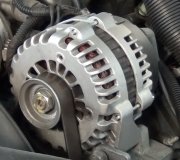Dandy. It appears voltage is not getting to the ASD relay to turn it on. You can verify the rest of the circuit is working by using a stretched out paper clip or a piece of wire to jump between the two fatter wires in the relay. If you turn on the headlights or have an under-hood lamp, you should see them get brighter when the alternator starts charging.
The secret is the no voltage to either of the small wires to the relay. The one in question is dark blue with no stripe. The other one is also dark blue but has a stripe. Here's the kicker. That dark blue wire also feeds the two air heater relays. Do you hear them click when you turn on the ignition switch? And do you hear them click off? I think they click off at the same time the "Wait to Start" light turns off. If they are clicking, the ignition switch is ok and the problem has to be between a splice in that circuit and the ASD relay.
If those air heater relays aren't working, the problem is in that dark blue wire circuit between the ignition switch and the splice between the relays. Suspect the switch first, and the connection in the bulkhead connector next. The problem can not be in the wiring before the ignition switch because it also feeds the radio and turn signals. You would have noticed them not working.
The ignition switches did cause a lot of trouble, but not on that circuit. Typically it is the contact that feeds the power windows, radio, and high-current drawing heater fan circuit that causes the trouble.
I think accessing that wire is easier at the ignition switch than at the bulkhead connector. If the air heater relays are clicking, skip this paragraph. If they are also dead, remove the covers on the steering column under the steering wheel. As I recall, there are four torx-head screws. Three hold the two halves together and one holds the bottom half to the column, then they snap apart. Due to the color issue, look at the size of the terminals in the back of the connector. There are seven terminals. Starting from one end, the first four are all large terminals. Starting from the other end, the first and third ones are much smaller. It's the larger one in between those two smaller ones you want, (the second from that end). There must be 12 volts there with the ignition switch turned to "run". If it is missing, double-check for voltage coming to the switch to prove to yourself it is there. That would be on the red wire which is the first large terminal on the other end of the plug with the four large terminals. If you jump between those two wires in the connector while the engine is running, lights should get brighter. That will be your proof the switch is defective or the terminals have overheated. If you see signs that the connector has melted or the first couple of inches of wire have become stiff, I'll describe how I replaced individual terminals without having to replace the entire harness. I'll skip that for now because the circuit you're in really doesn't have to handle that much current so I don't think that will be the problem.
If the air heater relays are working, the ignition switch and bulkhead connector have to be ok. The most likely suspect would be a corroded splice that has allowed one wire, (so far), to break loose from the rest. That splice is located inside the taped-up harness just under the rear edge of the hood, about 8 - 12" straight left of the wiper motor. It appears to be midway between the wiper motor and inner fender. Before you have tape flying in every direction, you might try flexing the harness in that area to see if the alternator starts working. If it does, you can have confidence you're in the right area. Either way, I don't like making a mess of harnesses by tearing them apart, but that might be what we have to do. You might have to find a helper if looking at the wire colors becomes a problem. There's another splice in that harness a few inches closer to the wiper motor. I can't tell how many wires there are in that splice or their color, but the splice you're after has five dark blue wires tied together. Check for voltage at that splice. If it is there, the problem is between that splice and the ASD relay. If it is missing, the problem is between that splice and the ignition switch.
Caradiodoc
Friday, July 23rd, 2010 AT 3:24 PM



